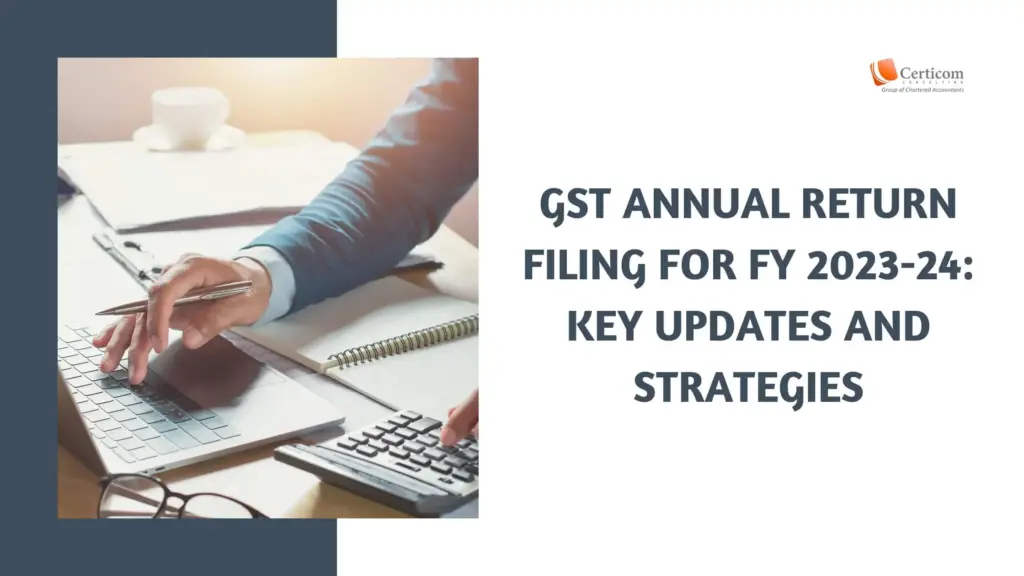GST Annual Return Filing for FY 2023-24: Key Updates and Strategies

Filing GSTR-9 and GSTR-9C can be a complex process, especially with new regulations, tighter scrutiny, and strict deadlines. However, with the right preparation and strategy, this task can become an opportunity to optimize financial processes and ensure regulatory compliance.
Significant Changes in GSTR-9 and GSTR-9C for FY 2023-24
1. Detailed ITC Reversal Reporting
Input Tax Credit (ITC) reversals under Rules 37, 42, and 43 require enhanced disclosures.
Includes proportional reversals for common inputs in taxable and exempt supplies and unpaid invoices over 180 days.
Ensure accuracy in reporting data under Table 7 to avoid penalties.
2. Reporting for E-Commerce Transactions
- Businesses transacting through e-commerce operators (ECOs) must align supply data and TCS deductions under Section 52.
- Discrepancies between business records and ECO data can lead to mismatches and penalties.

3. Mandatory HSN Code Disclosure
Taxpayers with turnovers exceeding ₹5 crore must report detailed HSN codes for outward supplies.
While inward supply reporting is optional, incorrect or missing HSN codes could result in compliance issues.
4. Revised Discrepancy Tolerance Limits in GSTR-9C
- Variances between books and returns are permitted up to 2% of turnover or ₹2 lakh, whichever is higher.
- Discrepancies exceeding this limit require proper justifications.
5. Emphasis on Prior-Year Adjustments
- Greater focus is placed on amendments and omissions from prior years.
- Accurate reporting in Part V is crucial, as highlighted in the GSTIN Advisory dated December 9.
6. Auto-Populated Data Enhancements
Figures from GSTR-1, GSTR-3B, and GSTR-2B are auto-populated with improved precision.
For FY 2023-24, ITC reconciliation must rely on GSTR-2B instead of GSTR-2A. Ensure alignment of your records with the auto-populated data.
7. Deadline for ITC Claims
ITC for FY 2023-24 must be claimed by the due date for October 2024’s GSTR-3B filing.
Missing this deadline can lead to the loss of eligible credits.
Common Mistakes to Avoid When Filing GST Returns
1. Discrepancies Between Returns and Books
Issue: Mismatches between GSTR-1, GSTR-3B, and books can trigger notices and penalties.
Solution: Reconcile turnover and tax amounts across all returns and records before filing.
2. Errors in ITC Reconciliation
Issue: Overclaimed ITC attracts penalties, while underclaimed ITC impacts cash flow.
Solution: Match ITC claims with GSTR-2B and reverse ineligible credits per applicable rules.
3. Neglecting Prior-Year Adjustments
Issue: Failing to report prior-year adjustments invites audits and scrutiny.
Solution: Include credit/debit notes and invoice amendments in Part V accurately.
4. Incorrect HSN Code Reporting
Issue: Non-compliance due to missing or incorrect HSN codes.
Solution: Verify and report correct HSN codes for all outward supplies.
5. Errors in E-Commerce TCS Reporting
Issue: Mismatched TCS deductions with ECO-reported data may lead to penalties.
Solution: Ensure internal records align with ECO-reported TCS deductions under Section 52.
6. Late Filing
Issue: Late fees of ₹200/day (capped at 0.50% of turnover) are levied for delays.
Solution: File GSTR-9 and GSTR-9C before the December 31, 2024 deadline.
7. Lack of Reconciliation Justifications
Issue: Unexplained variances invite further scrutiny.
Solution: Retain detailed records and provide justifications for all reconciliations.
Tips for a Seamless GST Return Filing Process
1. Start Early
Begin reconciling data from GSTR-1, GSTR-3B, and GSTR-2B well before the filing deadline to identify and address discrepancies early.

2. Utilize Technology
Leverage trusted GST reconciliation tools to automate error detection and ensure data accuracy.
3. Stay Deadline-Aware
Mark the December 31, 2024 deadline (or extensions, if any) on your calendar to avoid late fees and last-minute stress.
4. Seek Professional Advice
Consulting GST experts can simplify the filing process, ensuring compliance and optimizing ITC claims.
Filing GSTR-9 and GSTR-9C doesn’t have to be an overwhelming experience. By staying updated on the latest changes, avoiding common mistakes, and leveraging professional advice, taxpayers can ensure a smooth and hassle-free filing process.
Related Post
Have You Reported Your Foreign Assets in Your Income Tax Return?
A Beginner’s Guide to E-Filing Income Tax Return for FY 2024-25
Book A One To One Consultation Now For FREE
How can we help? *




